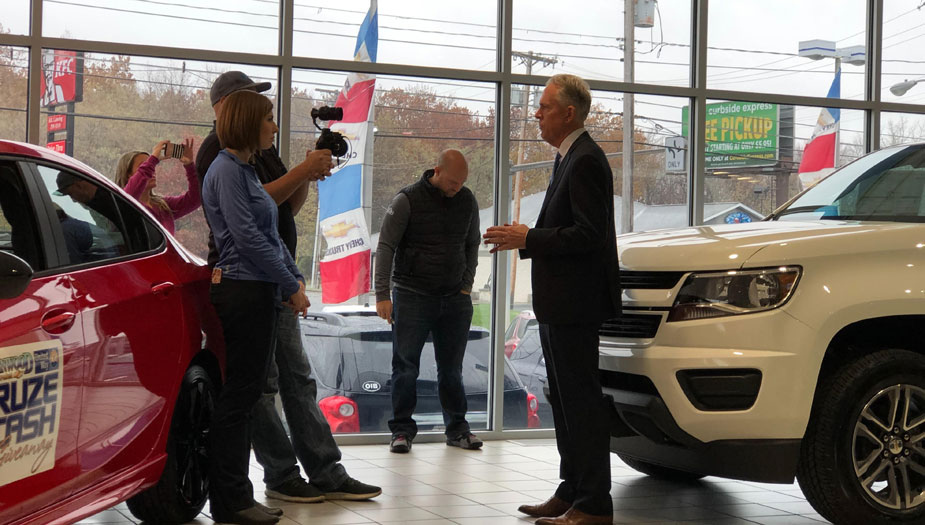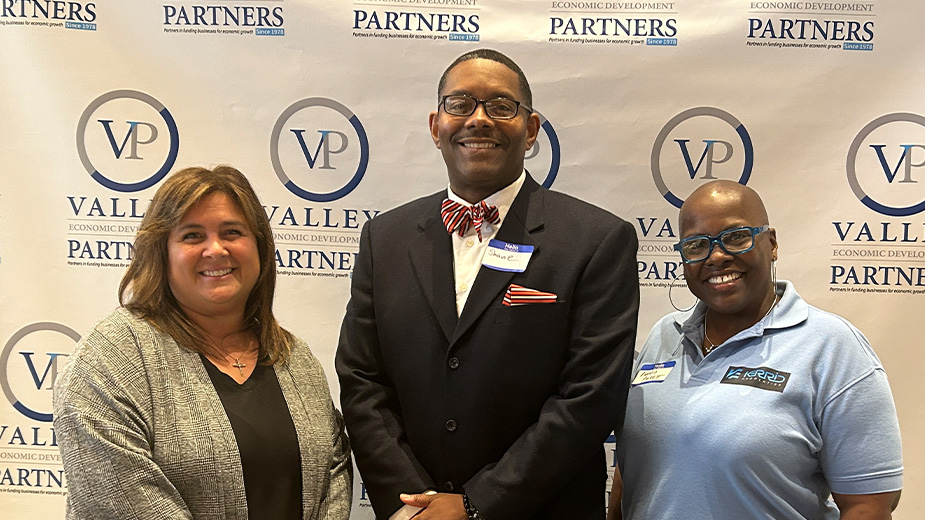Video Marketing Rolls on Multiple Platforms
YOUNGSTOWN, Ohio – Two women fix Greg Greenwood’s jacket as he stands in front of a video camera in his Mahoning Avenue dealership. Customers place their heads around a large, black Chevrolet truck to watch the action as the director, Jeff Ryznar, owner of 898 Marketing, calls, “Quiet on the set!”
Ryznar watches as his cameraman looks to Greenwood and back three times, lining up his shot, then calls, “Action!”
After a few more takes and adjustments to Greenwood’s lines, Ryznar is satisfied with the commercial. “That’s a wrap,” he says as the crew members and customers applaud. This is a typical video production day for a television commercial shoot, Ryznar says.
“We do corporate video as well as marketing with campaigns and advertising. We use traditional media, but the shift is really heading toward nontraditional and digital means where the attention and exposure is a longer form of engagement,” he says.
Ryznar and other owners of companies that provide video production companies, such as Jim Fogarty of 2 Ticks and The Dog Productions Inc. in Warren, George Farris of Farris Marketing and Chris Jaskiewicz of Advantage Video Production in Youngstown, have seen a change in the value of video marketing over the years. As more business owners realize the benefit of incorporating video in marketing strategies, “Video is the lifeline right now” for marketing agencies, Ryznar says. In the past year, he has seen an increase in video production projects at 898.
“Almost every client we’re working with now wants video. It’s one of the reasons we invested in an in-house video production company, TV Eye Productions,” Ryznar says. “We need that flexibility and the experts, who on a moment’s notice can be here at Greenwood Chevrolet or at United Way or the Youngstown Diocese to create that content and put it out to the public for mass consumption immediately.”
Business at Advantage Video is up 60% over last year, Jaskiewicz says, which he attributes to high demand for social media videos and TV commercials – and many clients asking for both. This required increasing the staff to seven, he says, and he plans to hire more and possibly lease more office space, too.
“There are videos we’ll create that go to somebody’s website, social media platforms and TV,” Jaskiewicz says. “We have a cinematic camera that can do national-type broadcast commercials all the way down to an iPhone for a quick social media post or video.”
With better quality cameras in iPhones and personal digital single-lens reflex, or DSLR, cameras, more people can produce their own content, says Fogarty of 2 Ticks and the Dog.
“Anybody can be a filmmaker, commercial video-maker without a big piece of equipment,” he says. “But they better have a good story and some technique and skill set. It’s good to empower your client so that they can start doing some of this stuff.”
Fogarty, who graduated from Bowling Green State University with a degree in film studies, got into independent filmmaking after college. While it’s something he still loves to do, he had to diversify his company from solely video production to a full media agency to accommodate the needs of his customers.
“Video has expanded to the point where we now make a [30-second video] for cable, and that same thing is going on a Facebook page and on a YouTube channel and in an email,” he says. “The video portion has gotten bigger and broader.”
Greater accessibility to cameras and mobile devices such as iPhones is “really a game-changer” because it’s empowered business owners to produce high-quality videos of their own, says 898’s Ryznar. As a result, more companies are engaging audiences with those videos over social media. However, Ryznar says there is a difference between what is posted to social media and what is made for TV.
“Social media is more whimsical, less structured and less controlled because of the environment it’s in. So you can be more personable and real, and have a more raw look to the footage,” Ryznar says. “But with traditional media, you only have about 30 seconds to capture that footage. So it has to be more structured and ordered.”
Farris of Farris Marketing agrees that anyone can make use of all the outlets for video to share their stories. He says the most important part of social media for video, especially YouTube, is to pay attention to the tags and keywords.
“YouTube is an amazing search engine. People forget that it’s a search engine, but that’s what it is,” he says. “The problem people usually have is that they are not marketing themselves well. They’re not checking to see what people are searching for and then wondering why their video isn’t doing well. If no one’s searching for it, they’re not going to find you, no matter how good it is.”
YouTube has more than one billion users, almost one-third of total internet users, and 72 hours of video are uploaded to YouTube every 60 seconds, reports WordStream.com.
Farris says he was always drawn to the concept of video and began producing a local television series in the 1980s. He produced a home-improvement show that was broadcast in five markets.
“It’s a powerful [medium] because you don’t have just visual or audio. You have the best of both worlds and that always appealed to me as far as marketing communications. It’s important to break through with your message so it stands out and is relevant,” he says
Farris works closely with customers on developing their messages and what will build the most interesting engagement for viewers, while also educating the audience on the company.
“Western Reserve Transit Authority is a client of ours. One challenge we had early on is people didn’t understand where the individual buses go,” Farris says. “It was the easiest thing in the world for us to create an animated bus route video to show where they each go.”
The company is also hosting a video contest for WRTA that features its mascot, Manny Quinn the mannequin.
“We place him in front of an area business or location along the direct lines of the buses, and we offer $50 in Visa gift cards. All we show is his face and we widen the shot until someone guesses where he is. It is one of our social media campaigns. And I don’t see a better way to promote than through social media,” Farris says. “Video campaigns that have similar themes between social media and commercials but are both interesting and fun. That’s the best.”
While the video production industry continues to evolve, Advantage’s Jaskiewicz says the original idea behind videos remains consistent: to tell a story.
“It’s about the audience you’re trying to reach, and the message you want to get across. Videos help people tell stories better than just writing it out,” he says. “Seeing someone’s face. Hearing a testimonial. It sticks with people better. Video is much more beneficial and the world is moving in that direction.”
898’s Ryznar gauges the success of a campaign by looking at metrics such as views, phone calls and emails that come in after a video has aired.
“If you don’t have a strategy behind it, that’s not marketing. You have to have clear, quantifiable goals,” he says. “Just because someone sees it doesn’t mean it was effective. And through social media, you can adjust instantly.”
Jaskiewicz predicts that holograms will be one of the next big developments and will allow viewers to “watch a football game in live time and see the players running across the field while sitting at a table. The football field would be the whole length of the table,” he says.
Ryznar agrees. “There’s a company called Magic Leap that is starting to surpass augmented reality with mixed reality,” he says. “Mixed reality means that a visual is so intertwined in daily life that it becomes a part of what you’re dealing with. For instance, a gymnasium can turn into a swimming pool with a whale that can jump out at them, and it feels real. That’s where everything is headed.”
Pictured: A video crew from 898 Marketing films a segment with Greenwood Chevrolet owner Greg Greenwood.
Copyright 2024 The Business Journal, Youngstown, Ohio.



